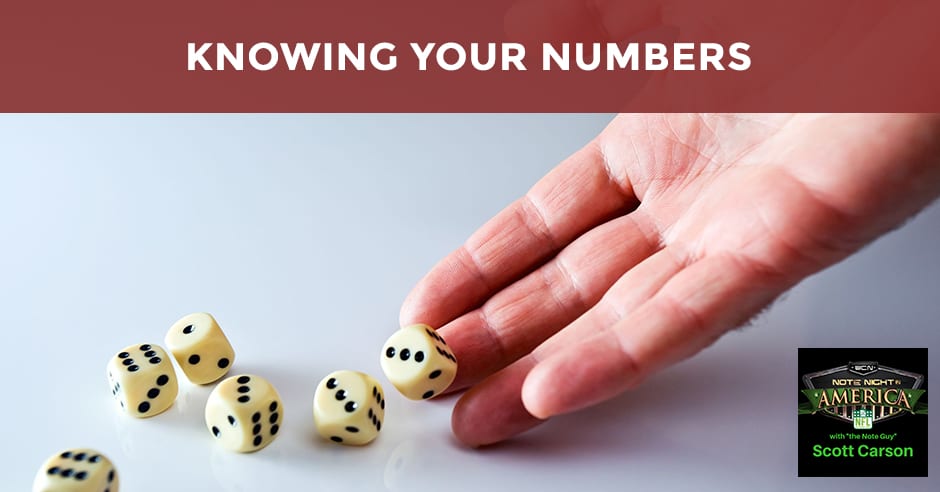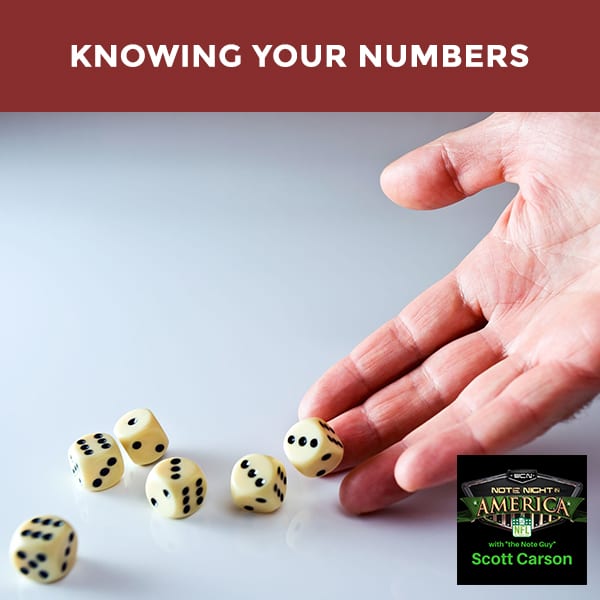
Most of us know our destinations and yet we’re clueless as to how to actually get there. The question is do we really know where we want to go or have we figured out the goal that we want to accomplish? It’s a series of questions but it all boils down to determining what is your why. Discovering the purpose of achieving the success that we want to attain and ensuring that it is strong enough to know that everything will be different this time around is essential. Scott talks about some of the things that people want to accomplish and the rules that coexist with having goals and knowing the numbers. He also reveals the four things that would actually solve the pain points of every person struggling to get to their destination.
—
Listen to the podcast here:
Knowing Your Numbers
You’re going to have some fun. We have note and real estate investors that are joining us here and people interested in the investment game. You will be able to catch the replays on WeCloseNotes.tv. One of the things that we also do is take these episodes and upload them to our podcasting platform for Note Night in America podcast, which we’re excited about that. We just went over 20,000 downloads on the Note Night in America podcast. Thank you for listening and subscribing. If you’re listening to this on the podcast, make sure to leave a review. We would love to know who’s listening on Stitcher or iTunes or any of the podcasting platforms. We did hit a big number. We had our 400th episode for the Note Closers Show Podcast.
We’d still be live streaming to Facebook for a while. I haven’t decided if we’re going to stop live streaming at the Facebook and sharing that to YouTube as well. We went over 210,000 downloads since we’re last on Note Night in America, over 10,000 downloads. I love for you to review and subscribe as well. We’ve got lots of great content, interviews, guests and vendors on the Note Closers Show podcast. If you’re not watching that are listening to that, please do so. That’s our flagship podcast for the show out here. There are a lot of events are coming up. There are some great events that are going on for all of you, whether you’re brand new or seasoned in the real estate industry. There are some great stuff for you to be tapping into.
Let’s talk about the upcoming event schedule. We have our next Fast Track Training of 2019, the 15th to the 17th of March. We’ve got one spot left available for that. You definitely want to take advantage of that for you and your partner or you and your spouse to come into that. We had a great Austin Fast Track Mastermind. We’ve got some great results of that. My buddy, Paul Cooper, was there for the Fast Track. He’s already landed an investor after sending an email blast out on a list that we helped provide. It’s already looking like he’s landed a seven-figure investor from the Fast Track Training.
We know what we are doing here. I’m so excited and absolutely blown away with a great group. Charles and Pam Wilson, Paul Cooper, Ben Ng, Mark, Jeff and Karen Bernsen, big Texas group of people. Paul is actually from Pueblo, Colorado but everyone else is from Central Texas. I expect a lot of good things from these people and stay tuned as you’ll see them marketing and share their messages when they got rock and rolling. Of course, the lovely Stephanie Goodman there in the mill smiling as well. We got about ten chapters left on this. If you want to get your story told, we have our Loan Tales book that we’re rolling out. Fifty note investors with different case studies. We’re going to be marketing it everywhere.
If you have a chapter and you want to get on the Note Closers Show podcast, we’ll talk about your story and your business and then we’ll be blasting it and marketing it everywhere. We’ll be distributing this to asset managers, REIA clubs, meetup groups, and conventions all across the country. We’ll be sharing what you’re doing and sharing the deals that you’re working through. It’s $599 per chapter. There are ten chapters left. You can go to LoanTales.com to RSVP your chapter before it’s expired. It’s an opportunity for you. Nobody else has done this in the note space. Actually, someone was on and said, “It’s a great thing.” Not me and not anybody in our group. He’s like, “It’s usually a $2,000 charge.”

Knowing Your Numbers: If you don’t know what you want to accomplish, that’s the first problem.
We’re just trying to do this stuff to cover our costs, editing and some of the marketing that goes along with it and help you guys. I’ll give you an example. I paid $10,000 to be in a book with Greg Reid. It’s an info book, Your Time Is Now. This is going to go out to investors all across the country. This is going to go out to asset managers. It’s definitely worth it to knock it in. We’re not being greedy here. We’re trying to cover our costs to get this thing rocking and rolling for you. For those that signed up, we’re excited to have you. Stay tuned and you’ll start seeing some stuff coming out to get you rock and rolling on your story. LoanTales.com is the link to get signed up. We’ll be glad to have you. I know a big goal for many people is they want to do more marketing or more writing. I know a big goal a lot of people have is, “I want to write a book.” Here’s your opportunity to be part of one of the best books for the note industry. You know I can market and here’s an opportunity for you to get marketed across our whole database. Trust me, $599 is well-below what I should be charging.
Know Your Numbers
Let’s dive into it. Knowing that your numbers hit your goals. We all have goals that we want to accomplish in the new year. We all agree to that, myself included. I’ve got some numbers that I want to hit this year. The big thing that most people don’t realize is first and foremost, what do you want to accomplish? If you don’t know what you want to accomplish, that’s the first problem. You’re probably like this guy who’s like, “What do I need to do to hit where I want to be? I don’t want 2019 to be a clone of 2018.” How many of you guys are ready for the year to be over for a fresh start? A chunk of you are. From the things I saw online, you’re talking like, “I’m so ready for 2018 to be over. I wanted it to be a new year.” It’s a new year and you have to start doing things now. Let’s talk about some of the things that people want to accomplish. Most of these are probably going to fall in line with what you’re looking for. You’re looking for it to close. You want to increase the number of deals that you’ve closed this year. A lot of you would want to do that.
They want to make more money. You also want to retire yourself or leave your job or retire your spouse. Maybe your parents, you want to help them out with their retirement or help them leave their jobs. They don’t have that worked so hard. We don’t want that for ourselves. We don’t want to be wearing the blue vest at 80. You want to help leave the job that you’re doing or help your spouse get out of whatever it is. We’ve got goals. Maybe you want to pay for your rug rats’ education. Maybe you want to send them to private school. Maybe you want to send them to college.
You want to do something. You want to pay for your kid’s education because let’s face it, your kids aren’t getting any younger. Maybe you want to work less and play a little more. Maybe you want to come to The Bahamas or you want to go on a cruise or you want to do something fun instead of being so bogged down and tired from always having a work. Maybe you want to go from working so hard to maybe working twenty hours a week or ten hours a week or whatever. You all have goals that you want to accomplish. The question I have to ask you is do you know what you want to do? What’s your goal? What do you want to accomplish? What is your why for achieving the success that you want to achieve? Is your why strong enough to help you make sure that 2019 is going to be different from 2018?
What are the actions? What are the activities that you’re doing in the new year? How are they going to be different from what you did last year and what you did the year before and the year before? If you find yourself in the same rut on that hamster wheel of doom, you have to do something. You have to get your ass off of there. Change up, shake it off and dive into doing something different. Take different actions to achieve different results. If you expect to achieve the different results with the same action you’ve done in the last few years, I’m sorry. This goes out to those that are closing deals too. The market has changed. You’ve got to tweak what you’re doing, doing things a little bit different than how it’s been done before. What I’m doing now is totally different from what I was doing ten years ago, five years ago or two years ago. We are doing some amazing things that we’re looking for.

Knowing Your Numbers: If you find yourself in the same rut on that hamster wheel of doom, you have to do something. You have to get your ass off of there, change up, shake it off, and dive into doing something different.
Rules Of Engagement
Let’s talk about some of the rules out here. Some of the rules to success because all about having goals is knowing the numbers and the rules behind what you’re focused on. The rules to work by, I guess you could say. The rules of engagement. If you want to get shot at, you just want to know what to do. You don’t want to be scared. You want people applauding the results of the end of the year. Let’s talk about some of the rules. Like we talked about before, what you did last year isn’t going to work. Our buddy, Chad Urbshott, one of our future mastermind members, talked about how he was on the phone with somebody, some idiot, some hedge fund who was wanting 75%, 80% of the unpaid balance. You have to start listening to me and start targeting more banks this year. Those are the things you’re going to have to do. One big thing too that you have to keep in mind and this is one of the big rules that scares the shit out of people.
People get scared like, “I can only make offers on the amount of money that I have in my IRA or the amount I have in my 401(k) or the amount that I had in my checking account. I got to go over here and break the piggy bank.” Zagging poor junior’s $5 out of his piggy bank to pay for the deal. Let’s get something straight. You’re not going to close 100% of the offers you make. It’s never happened. Nobody’s ever made 100 offers and closed on all 100 of those. It’s not going to happen. Also, if you want to reach the numbers that you want to hit, like many of you do, you’re going to have to make a lot more offers. Making one offer every blue moon or every time Halley’s Comet comes by, isn’t going to work. Every time Mercury is in retro or whatever isn’t going to work. You’ve got to make a lot more offers to hit the numbers that you want to do. It’s a fact of life. This also means when you’re making more offers, you’re going to have to market more.
Some are so scared, “I have to market more. What does that mean?” It means doing things differently. It means doing different things than you’ve done in the past. I’ve had a couple of people reach out to me. They’re like, “We’d love for you to come to speak at this event or can you come to speak to this event on the East Coast or on the West Coast?” I’m like, “No,” and they’re like, “What?” I’m like, “No offense, we’re doing things differently.” I’m not speaking at Expos for the most part. I’m not going to go to those things. They don’t drive traffic. I want to do things and spending time here with you is more effective. It’s better for my time management skills and the bigger bang for my buck to spend an hour with you that are on here. The guys and gals that listen to my podcasts. The people that I engage with on deals. It’s much more valuable for me to spend the time here than go somewhere else.
This also means getting outside of your comfort zone. You’ve got to do some things. You’ve got to spend time doing things that maybe you don’t want to do initially to expand your comfort zone. For some of you, what this means is you’re speaking less or writing less and making more offers. The thing that drives me bonkers in this whole industry is that you have a bunch of people that have closed on five deals and think they’re experts. A lot of people close on maybe ten deals or twenty deals or 30 deals and think they’re experts. No offense, if you close on 30 deals and it’s been a year since you made an offer or years since you closed on a deal, you should not be teaching.
Work On Your Numbers
There are people out there that are doing, “I’m an expert.” An expert in what? Did you raise any private capital for your deals? Did you use your own money? You’re not really an expert. How can you teach? If you have a salary coming in and you’re an employee, you can’t teach entrepreneurs how to succeed who are out there trying to make it on their own. It’s a whole different mindset. What I’m trying to get at here is you’ve got to get outside your comfort zone. Go close more deals. Some of my friends reach out to me, “What should we be focused on?” “Go make more offers. Go close more deals. Go raise more capital,” those are the things you need to do. “What do you say we get to work on those numbers? Let’s do that.”

Knowing Your Numbers: You have to start looking at these numbers as a game because it’s a system.
The first question is how many deals do I need to close to make money? Then the next question I’m going to ask is, “What’s your money goal?” Somebody throws out, “I want to make $5,000 per month in cashflow.” You want to make $5,000 per month in cashflow to you. That’s simple. Let’s run some numbers. Let’s say after servicing costs, monetary cost, splitting money or paying investors, you’re going to see $250 off that deal per month. You take that $250 divide it by $5,000 that’s twenty deals. Twenty deals are what you need to close in the next twelve months to get to the point at the end of this year, you’ve got $5,000 per month coming into cashflow.
Let’s face it. You’re not going to get every deal modified. You’re not going to get every deal going to be reperforming. You’re going to have some deals you make offers on that turn in the big checks, like $10,000 or $20,000 checks, if you take it back and then foreclose and do other things. For a simple method, you’re going to be targeting owner-occupied assets where the utilities are on, taxes aren’t too far behind and it’s occupied. Somebody wants to stay and have some private ownership. Like I mentioned before, you will only close on about 10% of the offers that you submit. You’re not going to go twenty for twenty. You’re not going to hit a perfect thousand. You’re not going to hit the hall of fame of note investors, “She made twenty offers and had twenty accepted right off the bat.” If that’s the case and you make twenty offers and you get twenty accepted, you’re probably overpaying. That should scare the crap out of you like, “They accepted all twenty of my offers, I overpaid.”
If you figure that you’re going to close on 10% of your offers, that means you needed to take twenty deals times 10%. That means you need to make a total of 200 offers. You need that offers made to hit that point roughly. If you divide that by 50 weeks out of the year, you’re probably going to take at least two weeks off. You’re not going to work around Christmas. We go off for vacation 4th of July because 4th of July is in the middle of the week. You’re probably working 50 weeks which means you may make four offers per week. Four offers per week times 50 weeks means 200 offers. That’s twenty offers roughly a month, give or take a little bit. That’s the offers you’ve got to make. Does this make any sense? You’ve got to be closing on one to two assets per month, maybe three. Who knows? Make some offers and get rejected. I’m not doing anything. I can make some more offers the following month. You’re going to get better at your due diligence.
You’re going to get better at your closing ratio. Even we are only at 35% to 40% closing ratio and what we make offers on. Don’t be expecting to go on hitting like Teddy Williams. If you’re not making four offers a week, what the heck are you doing? That’s not even one a day. There is no excuse that you can tell me that will keep you from making four offers. Unless you’re just sitting there twiddling your thumbs, whatever you’re doing. If you work full-time 80-hour week job, that’s a different story. Even if you’re working a full-time 40-hour week job, there is still time between 7:00 PM and 2:00 AM to make an offer.
You’d be reaching out to asset managers. You’d be reaching out to banks via email or in messages on LinkedIn or a whole variety of things you can do to get a list sent to you. The next thing that comes to because that what most people say, “How am I going to fund those deals, Scott? I don’t have money for twenty deals.” That’s okay because we’ve got a couple of things to help you out with this. I think this is going to be where the most amount of ideas or light bulbs go off for everybody out there. I don’t know about you guys but I feel like we’re dropping some great bombs here. How much OPM do I need? Let’s say the average fair market value of the asset is $50,000.

Knowing Your Numbers: If you want to reach the numbers that you want to hit, you’re going to have to make a lot more offers.
You’ll be seeing a lot of that with the nonperformance. That’s where you’re focused on first or contract for deeds. It’ll be highs and the lows or you’re just going with a load of numbers. If you’re going to fund these on a one-off basis at roughly 50% of the fair market value, let’s just assume unpaid balance is higher. That means $25,000 and you’ve seen this before in my $250,000 in 2018 presentation that I’ve done before. What does that mean? If you were going to fund at $25,000 and you’re buying twenty deals, that’s $500,000 in OPM. That’s awesome. That doesn’t seem like a lot but it is if you don’t do anything.
If you sit at home and look at the number like, “I’ve got to raise $500,000 in private money. What am I going to do? I don’t know. I’m going to go watch TV.” $500,000 in OPM is not that hard. I know if you’ve never raised $50,000, $500,000 looks ten times harder than something you’ve never done before. Trust me, everybody that has gone through our Fast Track and our mastermind closing deals, that’s the first thing. “Raising private capital was a whole lot easier than I expected. It was much easier to hit that mark than I ever expected,” because the fact is they’re doing things. Let’s talk about it. It’s very simple. You need twenty investors that have at least $25,000 a piece to fund one deal each basically. Maybe you’ve found ten investors that have $50,000 each or five investors with $100,000 each. You could owe two investors that have $250,000 each sitting in their IRAs or cash or something like that. The thing to keep in mind is it’s not that hard to do that. If you want to make money and start making six figures, you can find people. I guarantee you, most of you already have twenty people in your network that have at least that.
Email Out To Your Contact List
I know that when I went online and pulled some of the past surveys from our Note CAMP results, I know those numbers are out there quite a bit more. The way I look at it, most people on average have somewhere around $75,000 sitting in their retirement accounts. The question is how do you reach out to these people? If they’re already in your network, what’s the rule to getting them to say yes? Do I just get to sit in a smoke signal up and then they’ll run over or they’ll fall over dead with their legs up in the air with their IRA account numbers? No, you’ve got to market to them. Let’s talk about how many emails do you have to send? Let’s figure this out fast. The average connections that we see are people have roughly about 2,000 people in their database, either going to events, either on LinkedIn, they had pulled the LinkedIn connections or Facebook. One of the formulas that we have found is that at least everybody on average is worth about $1,000 in at least private money. On average, $1,000 across the board, some people are more bringing up for the average. 2,000 contacts in your database or the $1,000 a piece equal about $2 million in OPM. OPM stands for Other People’s Money.
If you send an email out to your database, you’re going to see in real estate on average, some of you are going to see higher results because you have a warm market. The average in real estate investing, mortgages or whatever, is about a 20% open rate. If you send an email out to 2,000 people, one-fifth of that is roughly 400 people. That will take 400 people that will open your email the first time around or most of the time times $1,000. That means there are roughly $400,000 in your random emails. It’s not a reason to open your email. That is just the case. The question is they’re not all going to respond. Are they all going to respond the first time I send an email? The answer to that is probably no.
The first time you send an email out, that’s usually about 2% of sales are made. You figure 2% of $400,000, it comes at roughly $8,000. Maybe somebody says, “I got $10,000, $15,000 in IRA. You say, “Awesome.” Let’s say the second week, you send another email out to your database saying, “Here’s another deal that we’re working on. Join me at the local meetup group. Here are some case studies that we focused on.” You’re probably going to get 3% of sales that are made on the second email. That means $12,000 in private capital plus the $8,000 from the week before which means you raised about $20,000 in capital in the first two weeks. Week three, you send another email to your database. That’s something else you got rock and rolling. 5% of sales are made in the third email, that’s $20,000.

Knowing Your Numbers: Get outside your comfort zone. Go close more deals.
$20,000 plus the $8,000 plus the $12,000 means you raised $40,000 roughly by week three. You send an email out for the fourth week in a row. Who do you look at this right now? Week one could be this week. Next week it would be week two. The third email will be the end of the month. The fourth email would be the first week of February. You got another $40,000 there. That means you’ve raised $80,000 in week number four. That would be enough probably to close roughly three of the deal so far for it. The thing is you’d have to keep this going because 80% of sales are made after the fifth contact. Let’s just say you’re a phenomenal emailer and on the fifth email, you raised $320,000 in week five or later.
The thing I’m trying to get at here is most investors never send more than one or two emails because if you’re brand new over half of you will never send an email out to your database. I guarantee the other half, only half of that half is going to send an email out maybe once to the database. That’s the sad thing. You won’t do the little things that it takes you to do to get where you need to be. It’s about as simple as that. How many emails have you sent? Five emails to 2,000 people are 10,000 emails, but only about 20% open rate. That means 2,000 people have opened your emails.
Keep recycling them. Just rinse and repeat. Get them in there and keep rinsing them and build a system. Replicate the email in MailChimp. Tweak it and change a few things. Change the title or change what you’re doing. Some of you are like, “Scott, I don’t have 2,000 people in my contact list because I’m brand new to this.” Let’s talk about growing your audience. Start networking at a local meetup and REIAs and taking their business cards and going home and put it in your database. Connecting to real estate investors on BiggerPockets. Go out there and post, ask questions and connect with people.
It’s easy to do. Connect with real estate investors on LinkedIn. You go over to LinkedIn, type in real estate investor and pull up thousands of people. Go and connect with them. If they connect with you, then you want to post something there. Maybe copy your email over there to start connecting or few photos, you can do this. Attend conferences or workshops. Go to Note CAMP. Go to the Quest event. Go to the Multifamily Investors Summit and start connecting with people. The idea is there are plenty of opportunities around if you will get off your keister and go do it and just do more. This is not a difficult business. Most of the things are done sitting on your butt or on your couch or wherever and doing a lot of the simple things over and over.
What you want to do is share your journey and the offers and deals that you are working on. Share the journey. Share what you’re working on. Share what you are actually getting off your butt and getting your muscles fit when it comes to real estate investing. I was in the gym here at noon and there are a lot of people like four groups in there. Two guys working out, a girl who’s on the treadmill. Two of the guys walked in, they turned around and walked back out. One guy walked in and change. He stood in the corner for 30 minutes, it’s funny. Me, I made it up. I did 100 push-ups, 100 sit-ups, 100 straight legs, 100 squats. I got in and out. I’m on my way. I’m doing the same thing over and over, we’re building that muscle. Build that muscle between your ears by doing these things over and over again. Trust me, the first email you send out is going to suck. Your first introduction when you go meet somebody at a conference or connect with somebody is going to suck. The idea here is just to get out. Everybody’s looking for something for you to do. Everybody’s looking to accomplish things in the new year. Why not you? Why not share what you’re doing? Why not share your goals?

Knowing Your Numbers: Most people on average have somewhere around $75,000 sitting in their retirement accounts.
One of the things that I have a big goal for this year is I want it to be a guest on 100 podcasts this year. I mentioned it in a podcast, “I got overwhelmed.” Let me spread these out. I’ve got interviews from now through the end of March lined up on other podcasts to help me with my audience. To help me get the word out on what I’m doing and help me expand my database. I’m sharing what I have. I’m going to podcasts. People I’ve never heard of before are responding, “We’d love to have you.” What’s that going to lead to is it’s going to lead to more people and will lead to more funding and lead to more deals closed.
Pulling IRA Letters And Mailing Those Out
Let’s talk about your audience. Let’s talk about what are some of the things that you need to do. A lot of us talk about mailing out to IRA investors. Let’s talk about the value of sending things out directly. Direct mail has a wonderful percent open response rate. This is talking about literally going to the county records, the county appraisal district and looking for those at Quest IRA or Equity Bust or Pensco or any of the other 40-plus self-directed IRA companies out there. Go to those and pull in that database. It’s going to take you a little bit of time. If you need twenty investors to fund your deals, how many postcards is it going to take? If you figure you’re going to get a 4% open response rate, it’s probably going to be better because you’re going to be dealing with a high-target rich environment. Let’s just say 4% on the low side, which I’ve never had a 4% response rate. It had been higher when we send out postcards.
If you got a 4% response rate to get twenty investors, that means you need to send out to 500 self-directed IRA. Let’s say it costs you $1 a postcard. You figure stamps are now going to $0.55 and then $0.45 for the postmark plus the ink to print on it. What are you going to say on the postcard? “I’m doing deals. Here’s the deal I’ve been working on. I see you’re a self-directed IRA investor. Would you like to talk or get coffee?” Get them on the phone to learn more about some things because we’re looking for more investors to sell these deals to or to partner with. The question is would you spend $500 to make $60,000 in cashflow for the year? The answer to that is always, “Yes, I would.” The answer really is, “No, you won’t.”
Reaching Out To Asset Managers Via Email
Many of you won’t do simple things to get ahead. You figured, if you take 500 postcards to make $60,000, it means every postcard you send out is worth $120 for it. You send out $1 postcard to make $120, that’s $120,000 return on investment or something like that. The question is, is it worth that to you? I don’t know. Some of you it is. Some of you it isn’t. Do you put a paragraph in the back of your postcard or you just let the art talk? I always put something on the back of my postcard. You may put, “I love to invite you to my webinar.” You put a link to a video you record or “Here’s our most recent deal that we closed at 25% or 35% of value.” You want to put something on the back of the postcard. Have them take interest, not just the artwork. You’ve got to appoint something on there to get their attention like, “Looking for deals in Central Texas, we can help.” Looking for more deals. How are you going to find more deals? Maybe you should start sending email to asset managers and pulling asset manager information off the Lane Guide and distressedpro right there at your fingertips for most of it. Start calling asset managers.
Here’s another concept dialing for dollars and talking to asset managers. Let’s talk about that. Would you make 50 phone calls to find one list or one deal? Yes or no? I’ll tell you a funny thing. We opened up Banking Blitzkrieg. Twenty-five people want to do it and half of them flaked off in the first week. The question I ask is, “Would you make 50 phone calls? Let me give you an example. The first time I made phone calls, I made 53 phone calls and got 52 noes before I got my first yes. That doesn’t count the ten that I called in my head practice and then the fifteen I get called and hung up on it fast because I was a nervous Nellie. 50 phone calls to find one list in one deal because on an average it’s going to come out to that. Most people won’t.
Let’s think about this, if you had to make 1,000 phone calls to find your twenty deals or 1,000 phone calls to make $60,000 that at the end of the year that $60,000 came in pretty much regularly for you. $60,000 divided by 1,000 phone calls means each phone call you dial is worth about $6. What I used to say is that every note I got was worth at least $5,500. I’ll give you an example. I made 70 phone calls over three weeks to get into the right department at Capital One. The first deal I closed with them, I made $35,000 and a wholesale fee on an eight-unit apartment complex. You take $35,000 divide that by 70 phone calls. That’s $500 for every note I got.
Making Phone Calls
That’s the thing you have to look at. You have to start looking at these numbers as a game because it’s a system. When you go out and you buy chickens from the grain store, you don’t expect all 100 of those chickens or how many chickens you buy to end up with three or four. I don’t know the number. I just remember as a young kid, like three years old, me and my grandfather go on to the feed store to buy 100 chickens or little chicks. Not many of them survived at the very end but that’s why you have the Law of Numbers. When I used to make phone calls from banks, it will be 50 phone calls to talk to thirteen to fourteen people. Those people I probably talk to sign for NDAs or for leads and out of those four leads, I’d end up with probably one.
Some weeks it was better than that. Other weeks it was worse than that. Sometimes I make 100 phone calls to get to the right department. The question is how many phone calls can you make it an hour? Do you knock out twenty phone calls an hour? That’s one phone call every three minutes. That’s pretty good money if you get to the right end. A lot of us have such a sense of entitlement, “I wanted you to come to me. I don’t have the strength or energy to make phone calls. It’s so 2001.” What I’m trying to get is you look at the numbers behind things. If you made 50 phone calls per day times twenty days to get 1,000 contacts. That means you are literally twenty days away from having some deals or making some money. I made phone calls three days a week, that’s Tuesday, Wednesday, Thursday. I don’t make phone calls on Mondays or Fridays, divided that by three days. That’s seven weeks away. Fifty phone calls a day. Call Tuesday, Wednesday, Thursday, 25 before lunch and 25 in the afternoon. That’s not hard to do if you will put it in place and get it done. Tuesday and Wednesday, 10:00 AM to noon, 2:00 PM to 5:00 PM.
When you face with your 50 phone calls, great. You make some phone calls fall back up, but it’s not that hard to do. This is a simple business if you do the things over and over again. If you’ve got emails to these asset managers, it’s a whole lot easier to email out and do the same thing as I talked about before, a 2% to 3% close ratio on the first email. You think about this six weeks between making phone calls or reaching out to asset managers or reaching out to your contacts. Six weeks of phone calls and emails to help you find and fund your deals. Six weeks, seven weeks, you’ll be there. That’s a whole lot better than wait until the end of the year.
The thing is I’m going to make phone calls one day a week. That’s fine. One day a week is fine. One is better than nothing. A little bit is better than nothing at all. Think about this, six weeks, seven weeks, fourteen weeks or twelve weeks. Whatever you do, look at your schedule, look at your calendar, look at the things you’re doing. Maybe you’re not mailing out 500 postcards this week. Maybe you’re dropping 50 because that’s all you had time to pull off the list. These little simple things or these four things; emailing out to your contact list, pulling IRA letters and mailing those out a little bit, reaching out to asset manager via email and making phone calls. Those are four magical things. That stuff is like the four legs of a chair to help you get where you need to be. The question you might ask is, “It worth it?” “Of course, it’s worth it,” but a lot of you will say, “I don’t have the time. I don’t want to do this now.”
Nobody said this is going to be the sexiest thing, “I’m going to be so involved. I’m going to strike a pose in my eternal good looks. I’m going to have asset managers falling at my door, ‘Please take a look at my deals.’” It doesn’t happen that way. Somebody has a question, “Do most banks sell off assets throughout each month or two? Most of them cram at the end of each quarter.” It varies. Most of them do quarterly sell-off. Also, if you’re reaching out, you’re going to come across hedge fund. You’re going to come across sources, stuff that they didn’t have to get rid of from last quarter. There’s never been a month in the year that I have not bought notes from banks or hedge fund of some sorts. That should answer your question.
I don’t worry about people in my Mastermind for the most part, as long as you’re out there closing deals. Keith Collins, $60,000 divided by $1,000 is $60 per call. That’s pretty good. Thank you for that. You’re right. I had my math wrong. It’s not $6 per call. It’s $60 per call. Thank you. You’re an honor and a scholar and a gentleman as well. My math is off. It’s even more beneficial. You made 50 phone calls in a day. It’s $60 per call because I had my math wrong here. It’s $3,000 a day. That’s pretty good. You don’t have to be a math wizard and simple math to be good at the note business. The question that I want to come back to you is what’s it worth to you? The whole thing is everyone can do what I just outlined. It is not difficult. We’re not talking twenty to 40 hours a week into this. You can do all these things at ten hours a week or less if you’re smart with your time.
A lot of the people I talked to on a regular basis, I see the message boards, I see the comps, I see the questions. I see the people running around in circles chasing all these damn squirrels, “Should I sign up for his education? Should I sign up for his workshop?” At some point, you have to quit taking workshops and start taking actions. You don’t want me to tell you, “I’m going to sell a workshop where the only thing you do while you’re in my workshop is to take action.” I don’t know what’s the other workshops that told you that’s all you could do? Let’s do that. Everybody can do what I just outlined, but you don’t know the number. You don’t know the outlines. You just don’t know and I get that, but most of you know the numbers because I have rattled them off to you up in Note Night in America over and over again.
It is what it is and I get it. We get sidetracked. We have projects, we have a family, we have excuses. We have stuff that happens. I get it. I’m not going to be the most productive person either, but I am going to be productive. I’m going to get things done even when I’m over in the Bahamas. I’ll be working. I’m going to be speaking. I’m going to be working on some email blast. I’m going to be working on some marketing and then taking some time to enjoy myself. It’s up to me and it’s up to you. You are in complete, 100% control of your future. You are in complete 100% control of 2019. It’s up to you whether you want to be successful at it or you just want it to be another mediocre year. If you’re dealing with issues, health, family, friends, financial issues, the best thing you can do is these four things because that’s what’s going to solve your issues. Going and closing more deals, raising more capital and talking to more investors. We have a question, “Can we buy the IRA list from you?” Yeah, I can help you with the list of IRA owners in your county. I don’t know if they’re self-directed but yes. You want to drop me an email. Tell me what county and state you’re in and I’ll be glad to find out how many are in there and then go from there for $1 a lead. That is all that I have for this episode. Hopefully, you will go out and make something happen. We’ll see you at the top.
Important Links:
- WeCloseNotes.tv
- Note Night in America podcast
- 400th episode of Note Closers Show
- Fast Track Training
- LoanTales.com
- Loan Tales
- Your Time Is Now
- LoanTales.com
- Note CAMP
- Multifamily Investors Summit
- Quest IRA
- Lane Guide
- distressedpro
- Banking Blitzkrieg

